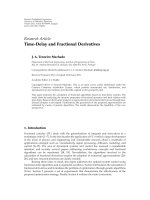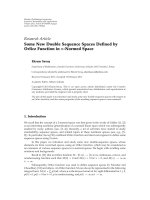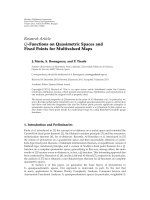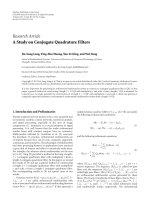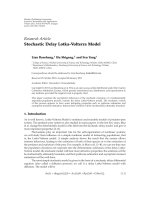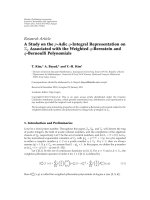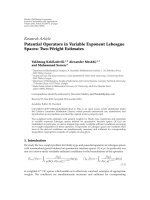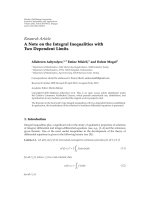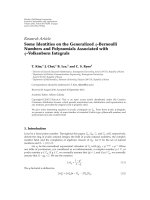Báo cáo hóa học: " Research Article Volterra-Type Operators on Zygmund Spaces" doc
Bạn đang xem bản rút gọn của tài liệu. Xem và tải ngay bản đầy đủ của tài liệu tại đây (510.76 KB, 10 trang )
Hindawi Publishing Corporation
Journal of Inequalities and Applications
Volume 2007, Article ID 32124, 10 pages
doi:10.1155/2007/32124
Research Article
Volterra-Type Operators on Zygmund Spaces
Songxiao Li and Stevo Stevi
´
c
Received 26 November 2006; Accepted 4 March 2007
Recommended by Robert Gilbert
The boundedness and the compactness of the two integral operators J
g
f (z) =
z
0
f (ξ)g
(ξ)dξ; I
g
f (z) =
z
0
f
(ξ)g(ξ)dξ,whereg is an analytic function on the open unit
disk in the complex plane, on the Zygmund space are studied.
Copyright © 2007 S. Li and S. Stevi
´
c. This is an open access article distributed under the
Creative Commons Attribution License, which permits unrestricted use, distribution,
and reproduction in any medium, provided the original work is properly cited.
1. Introduction
Let
D denote the unit disk in the complex plane C and ∂D its boundary. Denote by H(D)
the class of all analytic functions on
D.
Let ᐆ denote the space of all f
∈ H(D) ∩C(D)suchthat
f
ᐆ
= sup
f
e
i(θ+h)
+ f
e
i(θ−h)
−
2 f
e
iθ
h
<
∞, (1.1)
where the supremum is taken over all e
iθ
∈ ∂D and h>0. By a Zygmund theorem (see [1,
Theorem 5.3]) and the closed g raph theorem, we have that f
∈ ᐆ if and only if
sup
z∈D
1 −|z|
2
f
(z)
< ∞, (1.2)
moreover the following asymptotic relation holds:
f
ᐆ
sup
z∈D
1 −|z|
2
f
(z)
. (1.3)
Therefore, ᐆ is called Zygmund class. Since the quantities in (1.3) are semi norms (they
do not distinguish between functions differing by a linear polynomial), it is natural to add
them to the quantity
|f (0)|+ |f
(0)| to obtain two equivalent norms on the Zygmund
2 Journal of Inequalities and Applications
class of functions. Zygmund class with such defined nor m will be called Zygmud space.
This norm will be again denoted by
·
ᐆ
.
By (1.3), we have
f
(z) − f
(0)
≤
Cf
ᐆ
ln
1
1 −|z|
. (1.4)
Also, we have
f (z) − f (0) −zf
(0)
=
z
0
1
0
f
(tζ)ζdtdζ
≤
f
ᐆ
z
0
1
0
|ζ|dt
1 −t|ζ|
|
dζ|
≤
f
ᐆ
|z|
0
ln
1
1 −s
ds
=
f
ᐆ
|
z|+
|
z|−1
ln
1
1 −|z|
,
(1.5)
for every z
∈ D. From this and since the quantity
sup
x∈[0,1)
x +(x −1)ln
1
1 −x
(1.6)
is bounded, it follows that
f
∞
≤ Cf
ᐆ
, (1.7)
for every f
∈ ᐆ, and for some positive constant C independent of f .
We introduce the little Zygmund space ᐆ
0
in the following natural way:
f
∈ ᐆ
0
⇐⇒ lim
|z|→1
1 −|z|
f
(z)
=
0. (1.8)
It is easy to see that ᐆ
0
is a closed subspace of ᐆ.
Suppose that g :
D → C is a holomorphic map, f ∈H(D). The integral operator, called
Volterra-type operator,
J
g
f (z) =
z
0
fdg=
1
0
f (tz)zg
(tz)dt =
z
0
f (ξ)g
(ξ)dξ, z ∈ D, (1.9)
was introduced by Pommerenke in [2].
Another natural integral operator is defined as follows:
I
g
f (z) =
z
0
f
(ξ)g(ξ)dξ. (1.10)
The importance of the operators J
g
and I
g
comes from the fact that
J
g
f + I
g
f = M
g
f − f (0)g(0), (1.11)
where the multiplication operator M
g
is defined by
M
g
f
(z) = g(z) f (z), f ∈ H(D), z ∈ D. (1.12)
S. Li and S. Stevi
´
c3
In [2] Pommerenke showed that J
g
is a bounded operator on the Hardy space H
2
if
and only if g
∈ BMOA. The boundedness and compactness of J
g
and I
g
between some
spaces of analytic functions, as well as their n-dimensional extensions, were investigated
in [3–16] (see also the related references therein).
The purpose of this paper is to study the boundedness and compactness of integral
operators J
g
and I
g
on the Zygmund space and the little Zygmund space.
Throughout the paper, constants are denoted by C, they are positive and may differ
from one occurrence to an other. The notation a
b means that there is a positive con-
stant C such that a
≤ Cb. If both a b and b a hold, then one says that a b.
2. The boundedness and compactness of J
g
,I
g
: ᐆ → ᐆ
In this section, we consider the boundedness and compactness of the operators J
g
and
I
g
on the Zygmund space. To this end, we need two lemmas. Before formulating these
lemmas, we quote the following result from [17].
Theorem 2.1. Assume that f is a holomorphic function on
D and continuous on D. Then
the modulus of continuity on the closed disk is bounded by a constant times the modulus of
continuity on the circle.
By Theorem 2.1 and standard arguments (see, e.g., [18, Proposition 3.11]), the follow-
ing lemma follows.
Lemma 2.2. Assume that g is an analytic function on
D. Then J
g
(or I
g
):ᐆ → ᐆ is compact
if and only if J
g
(or I
g
):ᐆ → ᐆ is bounded, and for any bounded sequence ( f
k
)
k∈N
in ᐆ
which converges to zero uniformly on
D as k →∞, J
g
f
k
ᐆ
→ 0(or I
g
f
k
ᐆ
→ 0) as k →∞.
Lemma 2.3. Suppose that f
∈ ᐆ
0
, then
lim
|z|→1
f
(z)
ln
1/
1 −|z|
2
=
0. (2.1)
Proof. Since f ∈ ᐆ
0
, it follows that for every ε>0 there is a δ ∈ (1/2,1) such that
1 −|z|
f
(z)
<ε, (2.2)
whenever δ<
|z| < 1.
From (2.2), when δ<
|z| < 1, we have that
f
(z) − f
(0)
=
1
0
f
(tz)zdt
≤
δ/|z|
0
f
(tz)
|
z|dt +
1
δ/
|z|
f
(tz)
|
z|dt
≤f
ᐆ
δ/|z|
0
|z|dt
1 −t|z|
+ ε
1
δ/
|z|
|z|dt
1 −t|z|
≤
f
ᐆ
ln
1
1 −δ
+ εln
1
1 −|z|
.
(2.3)
4 Journal of Inequalities and Applications
Dividing (2.3)byln(1/(1
−|z|)) and letting |z|→1, we obtain
lim
|z|→1
f
(z)
ln
1/
1 −|z|
≤
ε, (2.4)
from which the lemma follows.
Now, we are in a position to formulate and prove the main results of this section.
Theorem 2.4. Assume that g is an analytic funct ion on
D. Then J
g
: ᐆ → ᐆ is bounded if
and only if g
∈ ᐆ.
Proof. Assume that J
g
: ᐆ → ᐆ is bounded. Taking the function given by f (z) = 1, we see
that g
∈ ᐆ.
Conversely, assume that g
∈ ᐆ. Employing (1.4)and(1.7), we have
1 −|z|
2
J
g
f
(z)
=
1 −|z|
2
f
(z)g
(z)+ f (z)g
(z)
≤
Cf
ᐆ
1 −|z|
2
g
(z)
ln
1
1 −|z|
2
+ Cf
ᐆ
1 −|z|
2
g
(z)
≤
Cf
ᐆ
g
ᐆ
1 −|z|
2
ln
1
1 −|z|
2
2
+1
.
(2.5)
On the other hand, we have that
J
g
( f )(0) =0,
J
g
( f )
(0)
=
f (0)g
(0)
≤
f
ᐆ
g
(0)
. (2.6)
From (2.6), by taking the supremum in (2.5)over
D and using the fact that the quantity
sup
x∈(0,1]
x
ln
1
x
2
(2.7)
is finite, the boundedness of the operator J
g
: ᐆ → ᐆ follows.
Theorem 2.5. Assume that g is an analytic function on D. Then I
g
: ᐆ → ᐆ is bounded if
and only if g
∈ H
∞
∩Ꮾ
log
, where
g
Ꮾ
log
= sup
z∈D
1 −|z|
2
g
(z)
ln
1
1 −|z|
2
. (2.8)
Proof. Assume that g
∈ H
∞
∩Ꮾ
log
.Thenby(1.4), we have
1 −|z|
2
I
g
f
(z)
=
1 −|z|
2
f
(z)g(z)+ f
(z)g
(z)
≤
Cf
ᐆ
g(z)
+ Cf
ᐆ
1 −|z|
2
g
(z)
ln
1
1 −|z|
2
≤ Cf
ᐆ
g
∞
+ Cf
ᐆ
g
Ꮾ
log
.
(2.9)
S. Li and S. Stevi
´
c5
On the other hand, we have that
I
g
( f )(0) =0,
I
g
( f )
(0)
=
f
(0)g(0)
≤
f
ᐆ
g(0)
. (2.10)
From this, by taking the supremum in (2.9)over
D and using the conditions of the theo-
rem, the boundedness of the operator I
g
: ᐆ → ᐆ follows.
Conversely, assume that I
g
: ᐆ → ᐆ is bounded. Then there is a positive constant C
such that
I
g
f
ᐆ
≤ Cf
ᐆ
, (2.11)
for every f
∈ ᐆ.Set
h(z)
= (z −1)
1+ln
1
1 −z
2
+1
, (2.12)
h
a
(z) =
h(az)
a
ln
1
1 −|a|
2
−1
(2.13)
for a
∈ D such that |a| >
√
1 −1/e. Then, we have
h
a
(z) =
ln
1
1 −az
2
ln
1
1 −|a|
2
−1
,
h
a
(z) =
2a
1 −az
ln
1
1 −az
ln
1
1 −|a|
2
−1
.
(2.14)
Thus for
√
1 −1/e < |a|< 1, we have
h
a
(z)
≤
2
1 −|z|
ln
1
1 −|a|
+ C
ln
1
1 −|a|
2
−1
≤
C
1 −|z|
, (2.15)
and consequently
M
1
= sup
√
1−1/e<|a|<1
h
a
ᐆ
< ∞. (2.16)
Therefore, we have that
∞ >
I
g
h
a
ᐆ
≥
I
g
h
a
ᐆ
≥ sup
z∈D
1 −|z|
2
h
a
(z)g(z)+h
a
(z)g
(z)
≥
1 −|a|
2
h
a
(a)g(a)+h
a
(a)g
(a)
≥
1 −|a|
2
2a
1 −|a|
2
g(a)+g
(a)ln
1
1 −|a|
2
≥−2|a|
g(a)
+
1 −|a|
2
g
(a)
ln
1
1 −|a|
2
.
(2.17)
6 Journal of Inequalities and Applications
Next, let
f
a
(z) =
h(az)
a
ln
1
1 −|a|
2
−1
−
z
0
ln
1
1 −aw
dw (2.18)
for a
∈ D such that |a| >
√
1 −1/e. Then, we have
f
a
(z) =
ln
1
1 −az
2
ln
1
1 −|a|
2
−1
−ln
1
1 −az
,
f
a
(z) =
2a
1 −az
ln
1
1 −az
ln
1
1 −|a|
2
−1
−
a
1 −az
.
(2.19)
Similar to the previous case, we have
M
2
= sup
√
1−1/e<|a|<1
f
a
ᐆ
< ∞. (2.20)
From this and by using the facts that
f
a
(a) = 0, f
a
(a) =
a
1 −|a|
2
, (2.21)
we have that
∞ >
I
g
f
a
ᐆ
≥
I
g
f
a
ᐆ
≥ sup
z∈D
1 −|z|
2
f
a
(z)g(z)+ f
a
(z)g
(z)
≥
1 −|a|
2
f
a
(a)g(a)+ f
a
(a)g
(a)
=
1 −|a|
2
f
a
(a)g(a)
=|
a|
g(a)
,
(2.22)
for
√
1 −1/e < |a|< 1. From (2.22), we see that sup
√
1−1/e<|z|<1
|g(z)| < ∞. From this and
by the maximum modulus theorem, it follows that g
∈ H
∞
, as desired.
From (2.17)and(2.22), it follows that
1 −|a|
2
)
g
(a)
ln
1
1 −|a|
2
≤
I
g
h
a
ᐆ
+2g
∞
≤ M
1
I
g
ᐆ→ᐆ
+2g
∞
< ∞ (2.23)
for every
√
1 −1/e < |a|< 1.
On the other hand, we have that
sup
|a|≤
√
1−1/e
1 −|a|
2
g
(a)
ln
1
1 −|a|
2
≤
1
e
max
|a|=
√
1−1/e
g
(a)
≤
sup
√
1−1/e≤|a|<1
1 −|a|
2
g
(a)
ln
1
1 −|a|
2
.
(2.24)
From (2.23)and(2.24), we obtain g
∈ Ꮾ
log
, finishing the proof of the theorem.
S. Li and S. Stevi
´
c7
Theorem 2.6. Assume that g is an analytic function on
D.Then,J
g
: ᐆ → ᐆ is compact if
and only if g
∈ ᐆ.
Proof. If J
g
: ᐆ → ᐆ is compact, then it is bounded, and by Theorem 2.4 it follows that
g
∈ ᐆ.
Now assume that g
∈ ᐆ and that ( f
n
)
n∈N
is a sequence in ᐆ such that sup
n∈N
f
n
ᐆ
≤
L and that f
n
→ 0uniformlyonD as n →∞.Nownotethatforeveryε>0, there is a
δ
∈ (0,1), such that
1 −|z|
2
ln
1
1 −|z|
2
2
<ε, (2.25)
whenever δ<
|z| < 1. Let K ={z ∈ D : |z|≤δ}.NotethatK is a compact subset of D.In
view of (1.4), (1.7), and (2.25), we have that
J
g
f
n
ᐆ
= sup
z∈D
1 −|z|
2
f
n
(z)g
(z)+ f
n
(z)g
(z)
+
f
n
(0)g
(0)
≤
sup
z∈K
1 −|z|
2
f
n
(z)g
(z)
+sup
z∈D\K
1 −|z|
2
f
n
(z)g
(z)
+sup
z∈D
1 −|z|
2
f
n
(z)g
(z)
+
f
n
(0)g
(0)
≤
Cg
ᐆ
sup
z∈K
f
n
(z)
sup
z∈K
1 −|z|
2
ln
1
1 −|z|
+ C
f
n
ᐆ
g
ᐆ
sup
z∈D\K
1 −|z|
2
ln
1
1 −|z|
2
+ g
ᐆ
sup
z∈D
f
n
(z)
+
f
n
(0)
g
ᐆ
≤
2C
e
g
ᐆ
sup
z∈K
f
n
(z)
+ CεLg
ᐆ
+2g
ᐆ
sup
z∈D
f
n
(z)
.
(2.26)
Since f
n
→ 0uniformlyonD, by the Cauchy estimate, it follows that f
n
→ 0uniformlyon
compacts of
D,inparticularonK. Using this, the fact that the quantity sup
x∈(0,1]
xln(1/x)
is bounded, that ε is an arbitrary positive number, by letting n
→∞in the last inequality,
we obtain that lim
n→∞
J
g
f
n
ᐆ
= 0. Therefore, by Lemma 2.2, it follows that J
g
: ᐆ → ᐆ is
compact.
Theorem 2.7. Assume that g is an analytic function on D.Then,I
g
: ᐆ → ᐆ is compact if
and only if g
= 0.
Proof. Assume that g
= 0. Then, it is clear that I
g
: ᐆ → ᐆ is compact.
Conversely, suppose that I
g
: ᐆ → ᐆ is compact. Let (z
n
)
n∈N
be a sequence in D such
that
|z
n
|→1asn →∞,andlet(f
n
)
n∈N
be defined by
f
n
(z) =
h
z
n
z
z
n
ln
1
1 −
z
n
2
−1
−
z
0
ln
3
1
1 −z
n
w
dw
ln
1
1 −
z
n
2
−2
. (2.27)
8 Journal of Inequalities and Applications
Similar to the proof of Theorem 2.5,weseethatsup
n∈N
f
n
ᐆ
≤ C and f
n
converges to 0
uniformly on
D as n →∞.SinceI
g
: ᐆ → ᐆ is compact, we have
I
g
f
n
ᐆ
−→ 0asn −→ ∞ . (2.28)
Thus
z
n
g
z
n
≤
sup
z∈D
1 −|z|
2
f
n
(z)g(z)+ f
n
(z)g
(z)
=
sup
z∈D
1 −|z|
2
I
g
f
n
(z)
≤
I
g
f
n
ᐆ
−→ 0
(2.29)
as n
→∞.Hence,weobtainlim
|z|→1
|g(z)|=0, which by the maximum modulus theorem
implies that g
= 0, as desired.
3. The boundedness and compactness of J
g
,I
g
: ᐆ
0
→ ᐆ
0
In this section, we study the boundedness and compactness of the operator J
g
(or I
g
):
ᐆ
0
→ ᐆ
0
. Before formulating the main results of this section, we need an auxiliary result
which is incorporated in the lemma which follows.
Lemma 3.1. AclosedsetK in ᐆ
0
is compact if and only if it is bounded and satisfies
lim
|z|→1
sup
f ∈K
1 −|z|
2
f
(z)
=
0. (3.1)
The proof is similar to the proof of [ 19, Lemma 1]. We omit the details.
Theorem 3.2. Assume that g is an analytic function on
D. Then
(a) J
g
: ᐆ
0
→ ᐆ
0
is bounded;
(b) J
g
: ᐆ
0
→ ᐆ
0
is compact;
(c) g
∈ ᐆ
0
.
Proof. (b)
⇒(a) is obvious.
(a)
⇒(c). Assume that J
g
: ᐆ
0
→ ᐆ
0
is bounded. Then, by taking f (z) = 1, we see that
g
∈ ᐆ
0
.
(c)
⇒(b). Assume g ∈ ᐆ
0
. Then, for any f ∈ᐆ
0
,by(1.4)and(1.7), we have
1 −|z|
2
J
g
f
(z)
=
1 −|z|
2
f
(z)g
(z)+ f (z)g
(z)
≤
Cf
ᐆ
1 −|z|
2
g
(z)
ln
1
1 −|z|
2
+ Cf
ᐆ
1 −|z|
2
g
(z)
≤
Cf
ᐆ
g
(z)
ln
1/
1 −|z|
2
1 −|z|
2
ln
1
1 −|z|
2
2
+ Cf
ᐆ
1 −|z|
2
g
(z)
.
(3.2)
S. Li and S. Stevi
´
c9
Taking the supremum in the last inequality over the set
{f ∈ H(D) |f
ᐆ
≤ 1},em-
ploying Lemmas 2.3 and 3.1,and(2.7), the compactness of the operator J
g
: ᐆ
0
→ ᐆ
0
follows.
Theorem 3.3. Assume that g is an analytic function on D.Then,I
g
: ᐆ
0
→ ᐆ
0
is bounded
if and only if g
∈ H
∞
∩Ꮾ
log
.
Proof. Assume that g
∈ H
∞
∩Ꮾ
log
. Then from Theorem 2.5, I
g
: ᐆ → ᐆ is bounded, and
hence I
g
: ᐆ
0
→ ᐆ is bounded. To prove that I
g
: ᐆ
0
→ ᐆ
0
is bounded, it is enough to show
that for any f
∈ ᐆ
0
, I
g
f ∈ ᐆ
0
.Now,forany f ∈ ᐆ
0
,wehave
1 −|z|
2
I
g
f
(z)
=
1 −|z|
2
f
(z)g
(z)+ f
(z)g(z)
≤
1 −|z|
2
g
(z)
ln
1
1 −|z|
2
f
(z)
ln
1
1 −|z|
2
+
g(z)
1 −|z|
2
f
(z)
≤
g
Ꮾ
log
f
(z)
ln(1/(1 −|z|
2
))
+
g
∞
1 −|z|
2
f
(z)
.
(3.3)
From (3.3) and by employing Lemma 2.3, we obtain the desired result.
Conversely, assume that I
g
: ᐆ
0
→ ᐆ
0
is bounded. Then it is clear that I
g
: ᐆ
0
→ ᐆ is
bounded. Since the functions defined in (2.13)and(2.18)belongtoᐆ
0
,weobtaing ∈
H
∞
∩Ꮾ
log
.
Theorem 3.4. Assume that g is an analytic function on D.Then,I
g
: ᐆ
0
→ ᐆ
0
is compact if
and only if g
= 0.
Proof. The sufficiency is obvious. Now we prove the necessit y. From the assumption that
I
g
: ᐆ
0
→ ᐆ
0
is compact, we see that I
g
: ᐆ
0
→ ᐆ is compact. Since the functions in (2.27)
belong to ᐆ
0
, similar to the proof of Theorem 2.7, we obtain the desired result.
Acknowledgment
The first author of this paper is supported in part by the NNSF of China (no. 10671115),
PhD Foundation (no. 20060560002), and NSF of Guangdong Province (no. 06105648).
References
[1] P. L. Duren, Theory of H
p
Spaces, vol. 38 of Pure and Applied Mathematics, Academic Press, New
York, NY, USA, 1970.
[2] Ch. Pommerenke, “Schlichte Funktionen und analytische Funktionen von beschr
¨
ankter mit-
tlerer Oszillation,” Commentarii Mathematici Helvetici, vol. 52, no. 4, pp. 591–602, 1977.
[3] A. Aleman and A. G. Siskakis, “An integ ral operator on H
p
,” Complex Variables. Theory and
Application, vol. 28, no. 2, pp. 149–158, 1995.
[4] A. Aleman and A. G. Siskakis, “Integration operators on Bergman spaces,” Indiana University
Mathematics Journal, vol. 46, no. 2, pp. 337–356, 1997.
10 Journal of Inequalities and Applications
[5] A. Aleman and J. A. Cima, “An integral operator on H
p
and Hardy’s inequality,” Journal
d’Analyse Math
´
ematique, vol. 85, pp. 157–176, 2001.
[6] G. Benke and D C. Chang, “A note on weighted Bergman spaces and the Ces
`
aro operator,”
Nagoya Mathematical Journal, vol. 159, pp. 25–43, 2000.
[7] D C. Chang, R. Gilbert, and J. Tie, “Bergman projection and weighted holomorphic functions,”
in Reproducing Kernel Spaces and Applications, vol. 143 of Oper. Theory Adv. Appl., pp. 147–169,
Birkh
¨
auser, Basel, Switzerland, 2003.
[8] D C. Chang and S. Stevi
´
c, “The generalized Ces
`
aro operator on the unit polydisk,” Ta iw an e se
Journal of Mathematics, vol. 7, no. 2, pp. 293–308, 2003.
[9] Z. Hu, “Extended Ces
`
aro operators on mixed norm spaces,” Proceedings of the American Mathe-
matical Society, vol. 131, no. 7, pp. 2171–2179, 2003.
[10] Z. Hu, “Extended Ces
´
aro operators on the Bloch space in the unit ball of
C
n
,” Acta Mathematica
Scientia. Series B. English Edition, vol. 23, no. 4, pp. 561–566, 2003.
[11] S. Li, “Riemann-Stieltjes operators from F(p,q,s) spaces to α-Bloch spaces on the unit ball,”
Journal of Inequalities and Applications, vol. 2006, Article ID 27874, 14 pages, 2006.
[12] S. Li and S. Stevi
´
c, “Reimann-Stieltjies type integral operators on the unit ball in
C
n
,” Complex
Variables Elliptic Functions, vol. 2, 2007.
[13] A. G. Siskakis and R. Zhao, “A Volterra type operator on spaces of analytic functions,” in Func-
tion Spaces (Edwardsville, IL, 1998), vol. 232 of Contemp. Math., pp. 299–311, American Mathe-
matical Society, Providence, RI, USA, 1999.
[14] S. Stevi
´
c, “Ces
`
aro averaging operators,” Mathematische Nachrichten, vol. 248/249, no. 1, pp. 185–
189, 2003.
[15] S. Stevi
´
c, “On an integr al operator on the unit ball in
C
n
,” Journal of Inequalities and Applications,
vol. 2005, no. 1, pp. 81–88, 2005.
[16] S. Stevi
´
c, “Boundedness and compactness of an integral operator on a weighted space on the
polydisc,” Indian Journal of Pure and Applied Mathematics, vol. 37, no. 6, pp. 343–355, 2006.
[17] P. M. Tamrazov, “Contour and solid structure properties of holomorphic functions of a complex
variable,” Russian Mathematical Surveys, vol. 28, no. 1, pp. 141–1731, 1973.
[18] C. C. Cowen and B. D. MacCluer, Composition Operators on Spaces of Analytic Functions, Studies
in Advanced Mathematics, CRC Press, Boca Raton, Fla, USA, 1995.
[19] K. Madigan and A. Matheson, “Compact composition operators on the Bloch space,” Transac-
tions of the American Mathematical Society, vol. 347, no. 7, pp. 2679–2687, 1995.
Songxiao Li: Department of Mathematics, Shantou University, Shantou, Guang Dong 515063,
China; Department of Mathematics, Jia Ying University, Meizhou, Guang Dong 514015, China
Email addresses: ;
Stevo Stevi
´
c: Mathematical Institute of the Serbian Academy of Sciences and Arts,
Knez Mihailova 35/I, Beograd 11000, Serbia
Email addresses: ;
